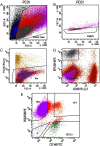Mesenchymal stem/progenitors and other endometrial cell types from women with polycystic ovary syndrome (PCOS) display inflammatory and oncogenic potential
- PMID: 23824412
- PMCID: PMC3763978
- DOI: 10.1210/jc.2013-1923
Mesenchymal stem/progenitors and other endometrial cell types from women with polycystic ovary syndrome (PCOS) display inflammatory and oncogenic potential
Abstract
Context: Endometrium in polycystic ovary syndrome (PCOS) presents altered gene expression indicating progesterone resistance and predisposing to reduced endometrial receptivity and endometrial cancer.
Objective: We hypothesized that an altered endocrine/metabolic environment in PCOS may result in an endometrial "disease phenotype" affecting the gene expression of different endometrial cell populations, including stem cells and their differentiated progeny.
Design and setting: This was a prospective study conducted at an academic medical center.
Patients and main outcome measures: Proliferative-phase endometrium was obtained from 6 overweight/obese PCOS (National Institutes of Health criteria) and 6 overweight/obese controls. Microarray analysis was performed on fluorescence-activated cell sorting-isolated endometrial epithelial cells (eEPs), endothelial cells, stromal fibroblasts (eSFs), and mesenchymal stem cells (eMSCs). Gene expression data were validated using microfluidic quantitative RT-PCR and immunohistochemistry.
Results: The comparison between eEP(PCOS) and eEP(Ctrl) showed dysregulation of inflammatory genes and genes with oncogenic potential (CCL2, IL-6, ORM1, TNAIFP6, SFRP4, SPARC). eSF(PCOS) and eSF(Ctrl) showed up-regulation of inflammatory genes (C4A/B, CCL2, ICAM1, TNFAIP3). Similarly, in eMSC(PCOS) vs eMSC(Ctrl), the most up-regulated genes were related to inflammation and cancer (IL-8, ICAM1, SPRR3, LCN2). Immunohistochemistry scoring showed increased expression of CCL2 in eEP(PCOS) and eSF(PCOS) compared with eEP(Ctrl) and eSF(Ctrl) and IL-6 in eEP(PCOS) compared with eEP(Ctrl).
Conclusions: Isolated endometrial cell populations in women with PCOS showed altered gene expression revealing inflammation and prooncogenic changes, independent of body mass index, especially in eEP(PCOS) and eMSC(PCOS), compared with controls. The study reveals an endometrial disease phenotype in women with PCOS with potential negative effects on endometrial function and long-term health.
Figures



Similar articles
-
Endometrial stromal fibroblasts from women with polycystic ovary syndrome have impaired progesterone-mediated decidualization, aberrant cytokine profiles and promote enhanced immune cell migration in vitro.Hum Reprod. 2015 May;30(5):1203-15. doi: 10.1093/humrep/dev055. Epub 2015 Mar 6. Hum Reprod. 2015. PMID: 25750105 Free PMC article.
-
Human Endometrial Fibroblasts Derived from Mesenchymal Progenitors Inherit Progesterone Resistance and Acquire an Inflammatory Phenotype in the Endometrial Niche in Endometriosis.Biol Reprod. 2016 May;94(5):118. doi: 10.1095/biolreprod.115.136010. Epub 2016 Apr 13. Biol Reprod. 2016. PMID: 27075616 Free PMC article.
-
Women with polycystic ovary syndrome present with altered endometrial expression of stanniocalcin-1†.Biol Reprod. 2020 Feb 14;102(2):306-315. doi: 10.1093/biolre/ioz180. Biol Reprod. 2020. PMID: 31494675 Free PMC article.
-
Polycystic ovary syndrome: Endometrial markers.Best Pract Res Clin Obstet Gynaecol. 2016 Nov;37:66-79. doi: 10.1016/j.bpobgyn.2016.03.008. Epub 2016 Apr 1. Best Pract Res Clin Obstet Gynaecol. 2016. PMID: 27156350 Review.
-
Uterine Function: From Normal to Polycystic Ovarian Syndrome Alterations.Curr Med Chem. 2018;25(15):1792-1804. doi: 10.2174/0929867325666171205144119. Curr Med Chem. 2018. PMID: 29210631 Review.
Cited by
-
Stanniocalcin Protein Expression in Female Reproductive Organs: Literature Review and Public Cancer Database Analysis.Endocrinology. 2024 Aug 27;165(10):bqae110. doi: 10.1210/endocr/bqae110. Endocrinology. 2024. PMID: 39186548 Free PMC article. Review.
-
Impact of metabolic disorders on endometrial receptivity in patients with polycystic ovary syndrome.Exp Ther Med. 2022 Mar;23(3):221. doi: 10.3892/etm.2022.11145. Epub 2022 Jan 14. Exp Ther Med. 2022. PMID: 35222698 Free PMC article.
-
Infertility and reproductive disorders: impact of hormonal and inflammatory mechanisms on pregnancy outcome.Hum Reprod Update. 2016 Jan-Feb;22(1):104-15. doi: 10.1093/humupd/dmv044. Epub 2015 Sep 22. Hum Reprod Update. 2016. PMID: 26395640 Free PMC article. Review.
-
Progestin-Containing Contraceptives Alter Expression of Host Defense-Related Genes of the Endometrium and Cervix.Reprod Sci. 2015 Jul;22(7):814-28. doi: 10.1177/1933719114565035. Epub 2015 Jan 28. Reprod Sci. 2015. PMID: 25634912 Free PMC article.
-
Endometrial stromal fibroblasts from women with polycystic ovary syndrome have impaired progesterone-mediated decidualization, aberrant cytokine profiles and promote enhanced immune cell migration in vitro.Hum Reprod. 2015 May;30(5):1203-15. doi: 10.1093/humrep/dev055. Epub 2015 Mar 6. Hum Reprod. 2015. PMID: 25750105 Free PMC article.
References
-
- Fauser BC, Tarlatzis BC, Rebar RW, et al. Consensus on women's health aspects of polycystic ovary syndrome (PCOS): the Amsterdam ESHRE/ASRM-sponsored 3rd PCOS Consensus Workshop Group. Fertil Steril. 2012;97(1):28–38.e25 - PubMed
-
- Villavicencio A, Bacallao K, Avellaira C, Gabler F, Fuentes A, Vega M. Androgen and estrogen receptors and co-regulators levels in endometria from patients with polycystic ovarian syndrome with and without endometrial hyperplasia. Gynecol Oncol. 2006;103(1):307–314 - PubMed
-
- Matteo M, Serviddio G, Massenzio F, et al. Reduced percentage of natural killer cells associated with impaired cytokine network in the secretory endometrium of infertile women with polycystic ovary syndrome. Fertil Steril. 2010;94(6):2222–7, 2227.e1–3 - PubMed
-
- Apparao KB, Lovely LP, Gui Y, Lininger RA, Lessey BA. Elevated endometrial androgen receptor expression in women with polycystic ovarian syndrome. Biol Reprod. 2002;66(2):297–304 - PubMed
Publication types
MeSH terms
Substances
Grants and funding
LinkOut - more resources
Full Text Sources
Other Literature Sources
Medical
Molecular Biology Databases
Miscellaneous

